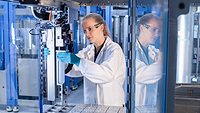Covestro Announces Biotechnology Plans for Sustainable Plastics
.jpg?1670341889)
Courtesy of Covestro.
Covestro announced plans to expand its competencies in industrial biotechnology. The plastics manufacturer intends to make increasing use of microorganisms and enzymes to make its products and processes even more sustainable. The company is developing new recycling processes based on biotechnology. To this end, its biotechnology competence center has been expanded to include a publicly funded research group. Covestro is also making progress in its efforts to produce the important chemical aniline entirely from plants for the first time with the help of microorganisms.
"Biotechnology has enormous potential to produce plastics in a more environmentally friendly and efficient way," said Markus Steilemann, Ph.D., CEO of Covestro. "As an innovation-oriented company, we want to expand our capabilities in this area. In particular, we expect this to provide further stimulus for the circular economy, to which we are completely gearing our company."
Covestro has established a junior research group enzyme catalysis (NEnzy), in order to better tap the potential of industrial (white) biotechnology for plastics production. It will receive a total of €2.5 million in funding from the German Federal Ministry of Education and Research for five years, and is cooperating closely with RWTH Aachen University in Germany. The new group is working to recycle end-of-life products and plastic waste through enzymatic recycling. The researchers also want to use enzymes to treat wastewater in plastics production. Another focus is the targeted and complete decomposition of used plastic in nature.
In a new laboratory that Covestro has built at its headquarters in Leverkusen, Germany, biotechnological processes can be represented in a particularly realistic way, in a wide range of sizes from one milliliter to soon 100 liters of reaction volume.
"We are taking nature as our model, which has created sensational processes and has practiced closed-loop recycling for millions of years," said Gernot Jäger, Ph.D., who heads Covestro's Biotechnology Competence Center. "With the help of enzymes and microorganisms, we can efficiently use alternative raw materials and thus replace fossil resources. At the same time, unwanted byproducts can be avoided or at least reduced significantly."
Covestro is already using biotechnology to research and develop new ways to sustainably produce aniline–obtained almost commonly from fossil raw materials, such as petroleum. Covestro needs aniline to produce a precursor (MDI) that is used to make insulating foam for buildings and refrigeration equipment. Together with partners from industry and science, Covestro has developed a process to produce aniline from plant-based raw materials, such as straw or sugar beet plants, in an environmentally compatible way using microorganisms.
Another precursor for coatings and adhesives (HMDA) can already be produced on a larger scale from plants and with the aid of biotechnology. Covestro and the U.S.-based biotech company Genomatica have succeeded in doing this through a partnership.
For more information, visit: www.covestro.com.
Looking for a reprint of this article?
From high-res PDFs to custom plaques, order your copy today!





